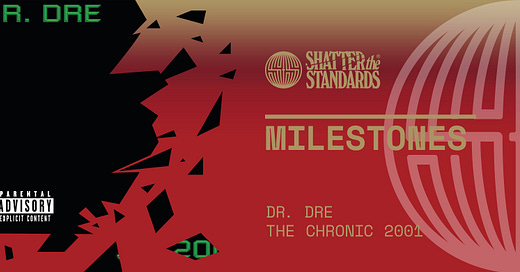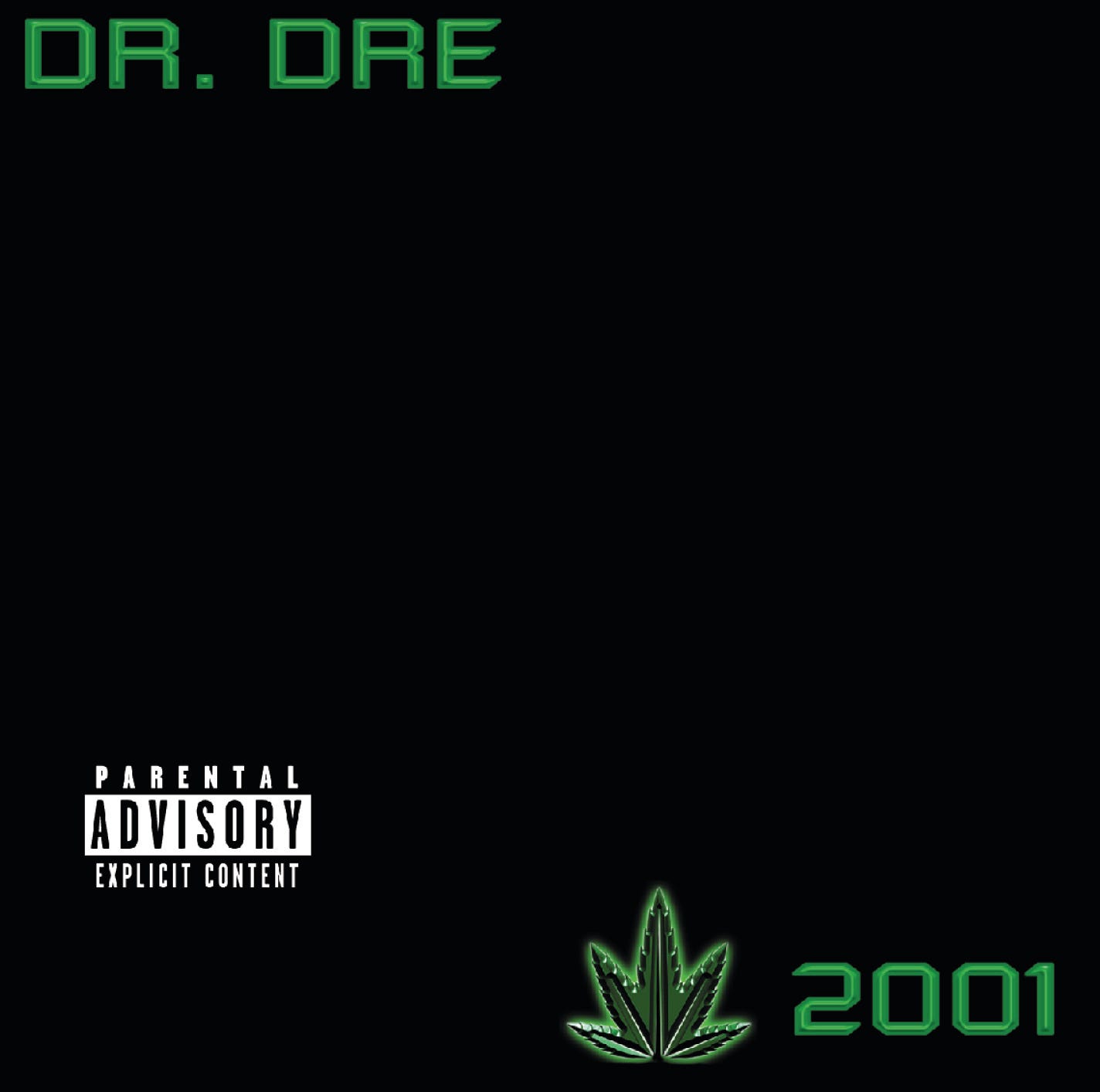Milestones: The Chronic 2001 by Dr. Dre
Coming off of the iconic debut album and two flopped Aftermath albums, Dr. Dre bounced back more than ever with an updated sound and laid the foundation for the G-funk sound of the 2000s.
October 2019. The club is packed, but the dance floor isn’t. Weed smoke wafts above the crowd, and monotonous electronic tunes anonymously bore from the speakers. The atmosphere is dull. Until the DJ brings a certain Scott Storch, aka Just-a-Piano-Man, to the virtual keyboards, and Snoop Dogg makes it clear: “Yeah nigga I’m still fucking with ya/Still waters run deep/Still Snoop Dogg and D-R-E, ’99 nigga/Guess who’s back.” The place ignites.
Twenty years earlier, on October 13, 1999, those lines, Storch’s hypnotically looped piano tunes, and mercilessly banging drums opened one of, if not the best beat of all time (perhaps rivaled only by “Shook Ones Part II” and I said what I said) and heralded the fourth spring of West Coast legend Andre. “Ladies, they pay homage, but haters say Dre fell off/How nigga? My last album was The Chronic.” Even LL Cool J would probably call this explosion a comeback.
Between 1992 and ’99, including the murders of 2Pac and Biggie and the implosion of Death Row Records, Dre hadn’t been able to work on a proper follow-up to his solo debut, The Chronic. Not that the Doctor hadn’t treated any beats in the meantime. Other producers would die for what some considered Dre’s “fall-off” after several classics and new sound inventions (World Class Wreckin’ Cru, N.W.A, The Chronic): songs like “Been There, Done That,” Ras Kass’ “Ghetto Fabulous,” The Firm album, or “Zoom.” We’re not even talking about founding his label Aftermath, discovering Eminem, and shortly before releasing The Slim Shady LP.
Nevertheless, the Doctor appears hungrier than ever in the fall of ’99. He wants to show everyone he wants the throne back. “They want to know if he still got it/They say rap’s changed/They wanna know how I feel about it (If you ain’t up on thangs)/Dr. Dre is the name/I’m ahead of my game.” After all, others, mostly from New York, dominated the rap game in the late ‘90s. DJ Premier had the fattest bass drum, Swizz Beatz the best synths, and JAY-Z ruled the clubs with Puffy. Until “Still D.R.E.” hit the airwaves. The track kills, burns, bounces, grooves, nods heads, and instantly owns every party. It doesn’t matter what year it is, what trend the internet is driving, which city is taking hip-hop to the next level.
With the advance single, Dr. Dre had already achieved his first goal: I’m back and still the best. “Niggas try to be the king, but the ace is back.” With the album following one month later, in November 1999, he laid the foundation for the G-funk sound of the 2000s and set standards for beats and production. He single-handedly freed the West Coast from Suge Knight’s dictatorship and post-2Pac depression, partly by reuniting with Snoop Dogg and bringing together the majority of L.A. rappers on The Chronic 2001. On the heavyweight slow jam “Some L.A. Niggaz” alone, he assembles underground artists like Defari, N.W.A compatriots like MC Ren, legends like King T, and new signings like Xzibit, and bring Knoc-Turn’al and Kokane into the studio for the classic funk hook.
2001 finally broke the chains of gangsta rap. “It’s a movie with various different scenes. You have emotional moments; you have aggressive moments. There’s even a bit of porn,” Dre told the New York Times at the time. In the opener, “The Watcher,” he convincingly plays the ghetto director: “Watched the lawsuits when they lost the dough/Best friends and money: I lost them both/Went visited niggas in the hospital/It’s all the same shit all across the globe/I just sit back and watch the show.” It pays off when you can haggle over erses with illustrious ghostwriters like The D.O.C., Royce da 5’9” (especially on the deep, East Coast-inspired “The Message” produced by Lord Finesse), and Eminem, alongside JAY-Z (“Still D.R.E.”).
“The Watcher” demonstrates from the first beat the newly found sound formula for 2001: Whipping synth strings duel with piano loops, deep basses, and hard-hitting snares, occasionally lightened by the infamous “Nuthin’ But a ‘G’ Thang” melodies. Mel-Man, Chris Taylor, Mike Elizondo (bass), and Scott Storch worked on the beats in the studio. Mel-Man is credited on every track, but Taylor and Storch’s keyboard skills are primarily responsible for the indestructible trademarks.
Josh Tyrangiel describes the recording process to the Times as follows: “Every Dre track begins the same way. The Doctor sits behind the drum machine, surrounded by trusted musicians. Once Dre has hammered out a raw beat, the musicians are asked to play melodies to the beat. If he hears something he likes, he pulls that person aside and continues to work on the sound for the track with them alone.”
For those who have always wondered why Dr. Dre’s productions boom louder and more pressingly through the speakers, rapper/producer Thes One of People Under the Stairs offers a possible explanation. “The Chronic was a sound engineering and mastering milestone. 2001, on the other hand, is cat shit. I know a sound engineer who was there at the time, and apparently, Dre wanted the ‘loudest CD ever.’ That’s a crazy statement, of course, because you simply can’t make a binary CD louder. I think they just wanted to blast the most monstrous boom out of the speakers.”
By now, it’s clear how much Dre wanted to burn everyone and everything. Particularly, the hard-hitting, Deep Cover-style pumping “Bang Bang” and “Murder Ink” make the blood either freeze in your veins or drip from your ears in the car. Similarly divided, at least from today’s perspective, is the view of Dre’s erotic fantasies on “Fuck You” and “Housewife.” Despite his long-standing marriage, his violent actions against women in the late ‘80s leave a slight aftertaste with these two-bedroom tracks and lyrics like “I just wanna fuck bad bitches/All them nights I never had bitches/Now I’m all up in that ass bitches/Mad at ‘cha boyfriend, ain’t ‘cha?/You’se a bad girl, gotta spank ya” or “I’m mannish, get yo’ nails out my back/Slut I’m bout to nut and get up, go scrub yo’ cat/Learn the player rules, this is how I play a dude”.
Other tracks seem much brighter, even today. “Xxplosive” inspires Kanye West, by his own admission, with its mix of soul and hard beats (compare the drum sound with Yeezy’s early works). “The Next Episode,” the last single, goes through as a kind of “Still D.R.E., Part Two” with its keys from Storch and delivers the most heavenly string arrangements ever in its video version right at the end. The musical father-son relationship with Eminem also positively affects Dre and the album. Their duet on the wildly bouncing “Forgot About Dre” and the catchy “What’s the Difference” elevate the two into the top five rap collaborations.
Until 2005, Dre and his producer army successfully varied the style found in 2001, with thick production, dramatically placed strings and keyboard sounds. He helps Eminem create his best album, gives 50 Cent the best club track of all time with “In da Club,” The Game rolls thanks to him (“How We Do”), and Busta Rhymes finds his perfect beat on “Break Ya Neck.” Somewhere after the incredible “Outta Control” remix for 50 Cent and Mobb Deep, however, the patterns repeat and lose momentum. The rap game moves on. Voices from the West become loud, saying Dr. Dre wants to reinvent himself for the fifth time with Detox and reclaim the throne.
But Detox remains a myth, and Dre stays successful as an executive producer, Aftermath talent scout (Kendrick Lamar), and businessman (Beats headphones). Only in 2015 does he meet his own standards with his Compton soundtrack without being able to or wanting to regain his former position in the rap game. That’s why even in 2024, in village disses, clubs, beach or apartment parties, it will still be: “It’s still Dre day nigga, AK nigga.”
Standout (★★★★½)




